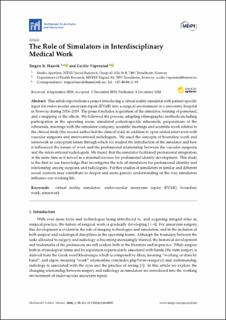| dc.contributor.author | Haavik, Torgeir Kolstø | |
| dc.contributor.author | Våpenstad, Cecilie | |
| dc.date.accessioned | 2021-04-20T14:52:18Z | |
| dc.date.available | 2021-04-20T14:52:18Z | |
| dc.date.created | 2021-01-15T21:18:31Z | |
| dc.date.issued | 2020 | |
| dc.identifier.citation | Multimodal Technologies and Interaction. 2020, 4 (90), 1-19. | en_US |
| dc.identifier.issn | 2414-4088 | |
| dc.identifier.uri | https://hdl.handle.net/11250/2738727 | |
| dc.description.abstract | This article reports from a project introducing a virtual reality simulator with patient-specific input for endovascular aneurysm repair (EVAR) into a surgical environment at a university hospital in Norway during 2016–2019. The project includes acquisition of the simulator, training of personnel, and a mapping of the effects. We followed the process, adopting ethnographic methods including participation in the operating room, simulated patient-specific rehearsals, preparations of the rehearsals, meetings with the simulator company, scientific meetings and scientific work related to the clinical trials (the second author led the clinical trial), in addition to open-ended interviews with vascular surgeons and interventional radiologists. We used the concepts of boundary work and sensework as conceptual lenses through which we studied the introduction of the simulator and how it influenced the nature of work and the professional relationship between the vascular surgeons and the interventional radiologists. We found that the simulator facilitated professional integration, at the same time as it served as a material resource for professional identity development. This study is the first to our knowledge that investigates the role of simulators for professional identity and relationship among surgeons and radiologists. Further studies of simulators in similar and different social contexts may contribute to deeper and more generic understanding of the way simulators influence our working life. | |
| dc.language.iso | eng | en_US |
| dc.rights | Navngivelse 4.0 Internasjonal | * |
| dc.rights.uri | http://creativecommons.org/licenses/by/4.0/deed.no | * |
| dc.title | The role of simulators in interdisciplinary medical work | en_US |
| dc.type | Peer reviewed | en_US |
| dc.type | Journal article | en_US |
| dc.description.version | publishedVersion | |
| dc.source.pagenumber | 1-19 | en_US |
| dc.source.volume | 4 | en_US |
| dc.source.journal | Multimodal Technologies and Interaction | en_US |
| dc.source.issue | 90 | en_US |
| dc.identifier.doi | 10.3390/mti4040090 | |
| dc.identifier.cristin | 1872437 | |
| cristin.ispublished | true | |
| cristin.fulltext | original | |
| cristin.qualitycode | 1 | |

